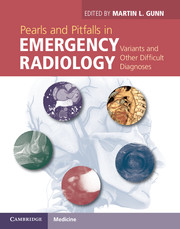Book contents
- Frontmatter
- Contents
- List of contributors
- Preface
- Acknowledgments
- Section 1 Brain, head, and neck
- Section 2 Spine
- Case 19 Variants of the upper cervical spine
- Case 20 Atlantoaxial rotatory fixation versus head rotation
- Case 21 Cervical flexion and extension radiographs after blunt trauma
- Case 22 Pseudosubluxation of C2–C3
- Case 23 Calcific tendinitis of the longus colli
- Case 24 Motion artifact simulating spinal fracture
- Case 25 Pars interarticularis defects
- Case 26 Limbus vertebra
- Case 27 Transitional vertebrae
- Case 28 Subtle injuries in ankylotic spine disorders
- Case 29 Spinal dural arteriovenous fistula
- Section 3 Thorax
- Section 4 Cardiovascular
- Section 5 Abdomen
- Section 6 Pelvis
- Section 7 Musculoskeletal
- Section 8 Pediatrics
- Index
- References
Case 25 - Pars interarticularis defects
from Section 2 - Spine
Published online by Cambridge University Press: 05 March 2013
- Frontmatter
- Contents
- List of contributors
- Preface
- Acknowledgments
- Section 1 Brain, head, and neck
- Section 2 Spine
- Case 19 Variants of the upper cervical spine
- Case 20 Atlantoaxial rotatory fixation versus head rotation
- Case 21 Cervical flexion and extension radiographs after blunt trauma
- Case 22 Pseudosubluxation of C2–C3
- Case 23 Calcific tendinitis of the longus colli
- Case 24 Motion artifact simulating spinal fracture
- Case 25 Pars interarticularis defects
- Case 26 Limbus vertebra
- Case 27 Transitional vertebrae
- Case 28 Subtle injuries in ankylotic spine disorders
- Case 29 Spinal dural arteriovenous fistula
- Section 3 Thorax
- Section 4 Cardiovascular
- Section 5 Abdomen
- Section 6 Pelvis
- Section 7 Musculoskeletal
- Section 8 Pediatrics
- Index
- References
Summary
Imaging description
The pars interarticularis (or pars) is a short segment of the vertebra located between the superior and inferior facets of the articular process. Spondylolysis, also commonly referred to as a pars defect, is a unilateral or bilateral osseous defect in the pars interarticularis and is most common at the L5 vertebral body level (Figure 25.1) [1]. Pars defects usually result from dysplastic pars at birth exposed to chronic repetitive stress.
The radiographic appearance of pars defects varies with the age of the lesion.
Acute traumatic pars defects occurring in a non-dysplastic vertebral level are rare and result from high-energy trauma [2]. They are usually hyperextension injuries, and can be missed on plain radiographs [3]. Findings that suggest an acute injury include irregular bony edges, lack of soft tissue calcification, and associated fractures (Figure 25.1).
In contrast, chronic injuries typically have smooth, rounded, and corticated edges (Figures 25.2 and 25.3). Fibrocartilaginous material will develop in the gap, subsequently replaced by hypertrophic bone (Gill’s nodules) [4]. Other imaging signs of a chronic unilateral spondylolysis include deviation of the spinous process and sclerosis of the contralateral pedicle [5]. Collimated lateral radiographs of the region of concern can help in questionable cases, but unless the beam is tangential to the defect, it may be missed [1, 4]. A five-view radiographic series (which includes 45 degree obliques) has a 96.5% sensitivity for the detection of pars defects [4].
Information
- Type
- Chapter
- Information
- Pearls and Pitfalls in Emergency RadiologyVariants and Other Difficult Diagnoses, pp. 87 - 89Publisher: Cambridge University PressPrint publication year: 2013
